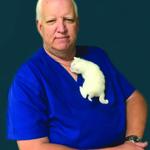TILTON — Usually, a parked SUV draws little attention. But one covered in plastic grass and imitation ticks the size of tennis balls, with mega-sized engorged ones on the roof, is an instant sensation — and not just a creepy crawly one.
“Way to go!” shouted a passing driver.
On Monday the “Tick Truck”or “Lyme-osine” from Quidel in San Diego arrived with the first set of 15-minute Lyme disease test kits for ClearChoice MD urgent care in Tilton, Belmont and Alton. Its skin prick tests analyze drops of blood in a vial for the presence of two kinds of Lyme antibodies — IgM, which usually develops after two weeks, and the body’s longer-term defense, IgG, which typically occurs four to six weeks after a bite from an infected tick. The test can be done while patients wait, and a positive results typically signal immediate treatment with the antibiotic, doxycycline.
For consumers it can be a valuable diagnosis at a point in time, without having to wait three to five days or longer for results to come back from an outside laboratory. But whether it will detect anything depends on whether you get tested at the right time — a consideration few consumers think about when they head to an urgent care center right after they’re bitten by a tick, develop a funny looking rash, or have some flu-like symptoms.
Lyme disease, a stealth invader, takes time to spark an immune defense in its victims. It’s also an illness that benefits from being caught in time — and from being cautious, taking wise precautions outdoors, and erring on the side of timely, proactive treatment when it looks like tick-borne disease is a significant risk. Disregarded, Lyme can dig in with chronic, often debilitating symptoms.
“Some people don’t have that bullseye rash,” said Meghan Baron, a physician’s assistant at ClearChoiceMD urgent care in Tilton, where providers can see two to five cases a day, or none for several days, she said. If medical staff suspect a high risk of Lyme or another tick borne illnesses, they send samples out for the Western blot test, a more time consuming and expensive test designed to detect several variants of Lyme disease and other infections that can be transmitted by ticks.
Quidel’s rapid results test and other commonly used two-tier (IgG and IgM) equivalents look for the most common Lyme variant, borrelia burgdorferi. Over 80% of tests come back negative, said a Quidel representative. According to current estimates from labs in Massachusetts and New Hampshire that collect and analyze ticks, 50- 60% of deer ticks (also called black legged ticks) carry Lyme disease. They’re much smaller than dog ticks, which peak in June and typically don’t transmit any known diseases to humans.
In the 50 years since Lyme disease was first discovered in Lyme, Connecticut, the American medical establishment has tried to come up with treatments and tests that work, and each have limitations. There are recommended protocols for Lyme treatment now, but not universal approaches, which are at the discretion of providers whose best go-to weapon remains antibiotics, usually a course of Doxycycline, which is most effective when used early on.
Lyme disease and tick-borne illness remain one of the most widespread public health threats in the Northeast, where ticks, Lyme disease and other tick-borne illnesses are common, followed by Wisconsin and Minnesota. Texas, California and Florida, with the next highest numbers, report plenty of Lyme cases, but a fraction of what’s New England. Here in the Northeast, we live in ground zero for ticks.
Each year, roughly 476,000 people in the U.S. contract Lyme disease, according to estimates by the U.S. Centers for Disease Control and Prevention. Historic trends indicate that children ages 5-14 and adults age 50-74 are at elevated risk, according to Marco Notarangelo, the vectorborne disease surveillance coordinator for the Department of Public Health at New Hampshire Department of Health and Human Services.
According to numbers from Quidel, based on CDC counts, New York, with 129,096 reported cases of Lyme, edges out Pennsylvania with 127,032. New Jersey follows with 81,259, Connecticut with 72,342, and Massachusetts with 53,393. New Hampshire leads northern New England with 16,729 cases over the same time period. For comparison, California, a much larger state, reported 3,441. When it comes to public health alerts, what counts most is the incidence of Lyme and tick-borne illness in the state’s population — how many cases versus the number of people who live there.
It's impossible to estimate how many tick encounters that result in medical visits or treatment are occurring in New Hampshire now. DHHS last tracked that data for hospital emergency rooms in 2010-2014, and now most people who have known run-ins with ticks or have suspicious symptoms, head to urgent care — which does not tally those numbers.
In 2022, CDC’s data tracker for emergency department visits related to tick bites classified all New England states as “high incidence” for Lyme disease. According to NH DHHS, there is currently no evidence that it’s becoming more prevalent over time, or that it increased during the pandemic, when more people spent time outdoors, but fewer were going to medical centers for diagnoses or treatment.
“Tick encounters can take place in any area where a tick might be able to survive,” said Notarangelo. Common hot spots include gardens, tall grass, parks, trails, areas rich in leaf litter, and bushes and other environments that might provide shelter for ticks during the warmest part of the day. An average of 30,000 to 40,000 cases of Lyme disease are reported to the CDC from state agencies each year, according to DHHS.
At urgent care centers, the number of visits related to tick-bites varies daily — although it’s a common reason to seek care, especially in spring, summer and early fall, said Baron.
The significance of Quidel’s rapid Lyme test is that it’s currently the only kit available that can get results within three to 15 minutes from a simple finger prick, according to Baron and Quidel labs. And this represents an advantage over Lyme antibody and other tests that must be sent out, leaving worried patients in limbo.
Although doctors have varied in how seriously they regard Lyme disease, most front-line providers pay close attention.
“If a patient comes in with a confirmed deer tick bite that was removed within 72 hours, they can be evaluated for Lyme disease prophylaxis with Doxycycline, based on current CDC guidelines,” Baron wrote in an email. Most of the time, to transmit Lyme, the tick has to be on for 36 hours, she added. “We get a lot of patients that just pulled a deer tick off.”
The economic cost of diagnosed Lyme disease in the U.S. has recently been estimated at $345 to $968 million a year, according to a report cited by DHHS.
Editor's note: This story was updated to reflect the correct timeframes during which the body develops its antibodies.




















(0) comments
Welcome to the discussion.
Log In
Keep it Clean. Please avoid obscene, vulgar, lewd, racist or sexually-oriented language.
PLEASE TURN OFF YOUR CAPS LOCK.
Don't Threaten. Threats of harming another person will not be tolerated.
Be Truthful. Don't knowingly lie about anyone or anything.
Be Nice. No racism, sexism or any sort of -ism that is degrading to another person.
Be Proactive. Use the 'Report' link on each comment to let us know of abusive posts.
Share with Us. We'd love to hear eyewitness accounts, the history behind an article.